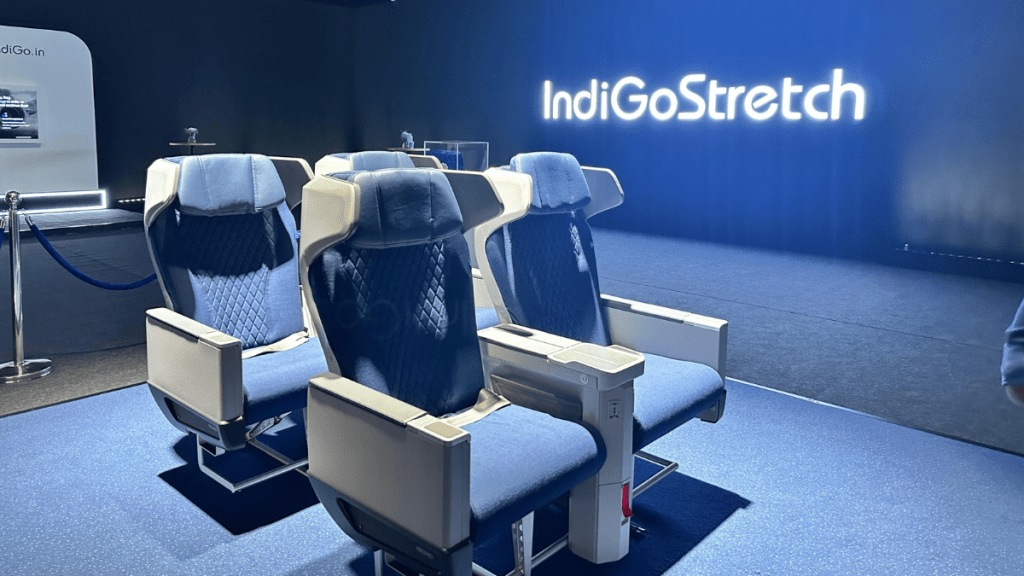In a remarkable two-day span, India’s aviation landscape shifted dramatically. Just as Air India completed its long-awaited merger with Vistara, bringing the two full-service carriers under one roof, IndiGo — known for its steadfast low-cost model — rolled out its business-class seats on select domestic routes. Together, the two command over 90% of the domestic aviation market.
IndiGo’s new business class, branded IndiGo Stretch, was launched on Thursday on the high-traffic Delhi-Mumbai sector. The offering includes spacious seats in a 2-2 configuration, a healthy vegetarian meal selection from Oberoi Catering, a power outlet, and various other comforts at an introductory price of Rs 18,018, almost 30% cheaper than rival Air India’s business class, which is priced around Rs 26,000.
For a brand that has worn affordability and simplicity as a badge of honour, this shift is driven as much by competition as by evolving customer needs, say experts. It is also indicative of a broader industry trend toward improved passenger experiences, even among budget carriers. “IndiGo’s move is both a response to competition and a step to fill the gap left by Jet Airways,” says Anjali Chopra, associate professor of marketing at KJ Somaiya Institute of Management.
lndigo had to move fast given the massive advantage the merger with Vistara offers Air India, which had also acquired 470 new jets last year to bolster its presence in both domestic and international markets. In fact, the airline’s low-cost subsidiary, Air India Express, is also set to reconfigure planes with business class seats in April 2025. “By offering a differentiated service, Indigo can strengthen its position and potentially mitigate the impact of increased competition and potential market consolidation,” says Yasin Hamidani, director, Media Care Brand Solutions.
Flying high
India is the world’s third-largest domestic aviation market, following the US and China. In April this year, India’s domestic airline capacity reached approximately 15.6 million, a substantial increase from 8 million in April 2014.
Stretch gives IndiGo access to the lucrative business travel sector, which, though small in India, is growing at a double-digit growth rate. Premium seats — comprising business and first class — constitute only about 1% of the total domestic capacity currently but are growing at a rate that exceeds that of the economy segment. According to industry data, premium economy seating selections doubled and business class selections grew three times in the post-Covid period.
“IndiGo’s business class is a direct response to the growing need among travelers for comfortable, adaptable options,” notes Bharatt Malik, senior VP at Yatra Online.
Air India dominates the premium market, offering full-service perks on metro routes and long-haul flights. “By bridging the gap between budget and premium travel, Indigo is giving customers the opportunity to enjoy high-end services at a competitive price, effectively democratising luxury air travel,” adds Nishant Pitti, CEO of EaseMyTrip.
In other words, premiumisation is a necessity for Indigo rather than an option. “At one point in time, the low-cost airline strategy worked as there were multiple players and hence customers had options. The good-better-best approach to pricing needs to move beyond price-sensitive customers and also serve high-end customers who are ready to pay,” says KJ Somaiya Institute’s Chopra. This is possible through a multi-tiered offering, where the good option is a basic, stripped-down product, while a better option would be premium economy and the best option is where customers pay for better and superior service (business class, priority check-in and luggage arrival, more legroom, better in-flight services etc).
IndiGo’s business class is a sign that the boundaries between budget and premium are blurring, opening the skies to a new era where affordable and high-end options coexist, say observers. While one might expect IndiGo’s business-class entry to spark a price war in the segment, the real contest will likely revolve around value rather than slashing ticket prices, says Yatra Online’s Malik. Instead of engaging in direct price competition, he envisions airlines competing through enhanced offerings and tiered pricing models. As airlines add unique amenities, the focus will likely shift to the experience and perceived value rather than cost alone.

